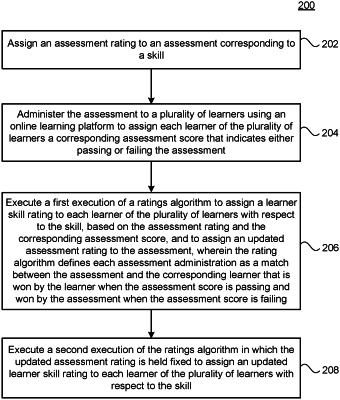| CPC G09B 7/04 (2013.01) [G06Q 50/20 (2013.01); G09B 5/12 (2013.01)] | 20 Claims |

|
1. A computer program product, the computer program product being tangibly embodied on a non-transitory computer-readable storage medium and comprising instructions that, when executed by at least one computing device, are configured to cause the at least one computing device to:
store an assessment rating for an assessment corresponding to a skill in an assessment database, the assessment rating being assigned using a standard rating scale;
administer the assessment to a plurality of learners via a network and using an online learning platform to assign each learner of the plurality of learners a corresponding assessment score that indicates either passing or failing the assessment, wherein the assessment has an assessment type of a plurality of assessment types and the assessment score is determined independently of the standard rating scale and is based on the assessment type;
execute an assessment convergence execution of a rating algorithm at a first time to assign a learner skill rating, using the standard rating scale, to each learner of the plurality of learners with respect to the skill, based on the assessment rating and the corresponding assessment score, and store each learner skill rating in a learner rating database, wherein the rating algorithm defines each assessment administration as a match between the assessment and the corresponding learner that is won by the learner when the assessment score is passing and won by the assessment when the assessment score is failing, and further wherein the assessment convergence execution causes the assessment rating to converge to a converged assessment rating on the standard rating scale while processing the learner skill rating of each learner of the plurality of learners;
execute a learner skill rating correction execution of the rating algorithm at a second time in which each learner skill rating is retrieved from the learner rating database and processed with the converged assessment rating being held fixed on the standard rating scale to thereby assign a corrected learner skill rating to each learner of the plurality of learners with respect to the skill and replace each learner skill rating with a corresponding corrected learner skill rating in the learner rating database and using the standard rating scale;
determine a current learner of the plurality of learners, the current learner having a corresponding corrected learner skill rating that provides a current learner skill rating for the current learner within the learner rating database;
find, within the assessment database, for the current learner and in response to the storing of the current learner skill rating, a second assessment corresponding to the skill and having a second assessment rating assigned using the standard rating scale; and
provide the second assessment to the current learner via the network and using the online learning platform to thereby provide an adaptive learning experience for the current learner.
|